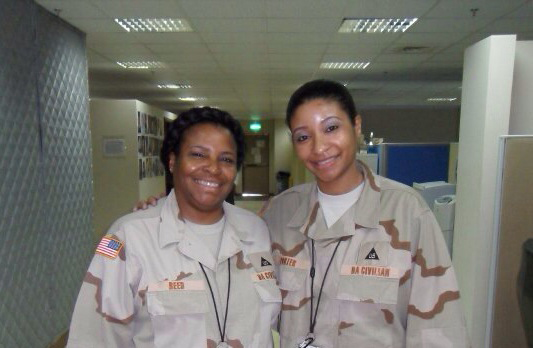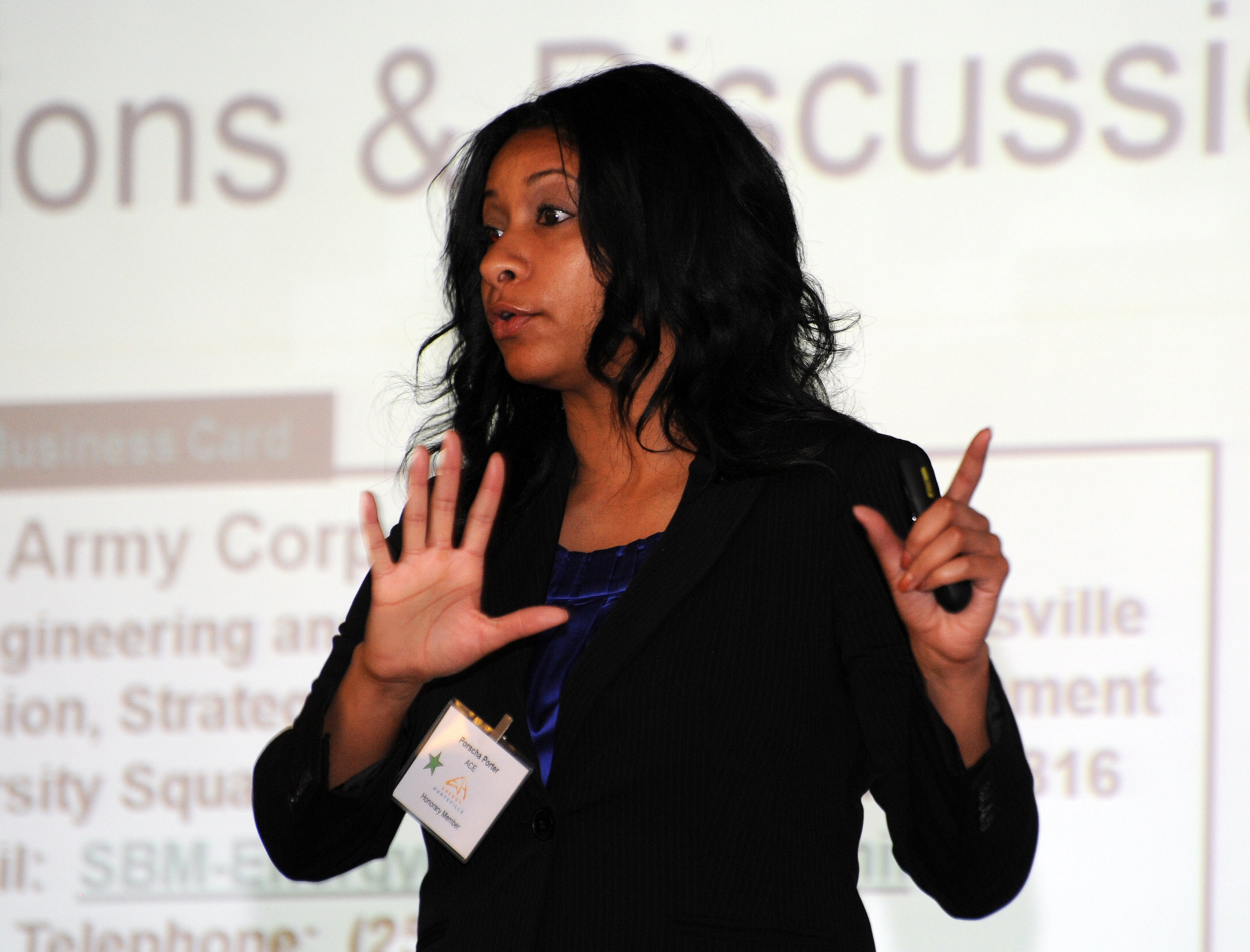
Command/Organization: U.S. Army Engineering and Support Center, Huntsville, Alabama
Title: Chief, Energy Division Strategy and Business Management Branch
Years of Service in Workforce: 11
Education: M.S. in management, Florida Institute of Technology; B.S. in electrical engineering, Alabama A&M University
DAWIA certifications: Level III in engineering; Level II in program management; Level II in facilities engineering; Level I in test and evaluation. Certified Project Management Professional; member of the Huntsville Project Management Institute and the Society of American Military Engineers.
Awards: Women of Color in Technology Rising Star Award; DA Superior Civilian Service Award; Commander’s Award for Civilian Service
Thanks, Mom
By Susan L. Follett
Around the acquisition and contracting community, deployments are almost commonplace. But Porscha Porter’s deployment is a little different than most: Not only did her mother recommend she deploy—her mom went first.
“My mom deployed to Kuwait in 2009, as a budget analyst working in resource management for AMC [the U.S. Army Materiel Command], and she recommended that I deploy, too,” said Porter. She followed six months later as a senior facilities engineer. “It was the best job I’ve ever had, and I loved every minute of it. I would encourage my kids to have federal careers and to deploy in service to their country. And if my kids ever deploy, I told them I’d come with them.”

Porscha Porter, right, and her mother, Margie Reed, deployed together in Kuwait in 2010: Reed went first, and Porter followed six months later. (Courtesy photo)
Porter’s mother, Margie Reed, has played a big role in getting her to where she is today: chief of the Energy Division’s Strategy and Business Management Branch for the U.S. Army Engineering and Support Center in Huntsville, Alabama.
“The work I did on deployment motivated me to join the [U.S.] Army Corps of Engineers when I got back,” she said. “But I never thought I’d be doing this kind of engineering. When I graduated from college, my mom was working for the Corps, and she suggested I look into working there, too. But I wanted a desk job—to be one of those Silicon Valley engineers who created the next big thing. Thanks to my mom, I ended up in boots and a hardhat, working in construction engineering in Kuwait. So my advice to others is to keep your options open—the job you think you’ll hate will be the one you love the most. And listen to your mom.”
What do you do in the Army? Why is it important?
As the Strategy and Business Management Branch chief, I manage the Huntsville Center’s Energy Division strategic development team, providing a unique combination of services: strategic development for net zero planning, microgrid solutions, international and interagency support, energy center of expertise and sustainability, and support for the Army’s Office of Energy Initiatives. Our team plays a key role in developing frameworks and energy concepts and initiatives into viable programs by leveraging our expertise, providing outreach and pursuing partnerships within the energy community.

Porscha Porter, deployed to Kuwait for 18 months as a senior facilities engineer, works out details with Daniel Raymond at Camp Arifjan in 2011. (Courtesy photo)
What’s the most challenging aspect of the work you do? What’s the most important skill for doing it well?
Helping shape the direction of a “big vision” team like ours can be challenging. A lot of our work involves developing plans and strategies to implement new energy initiatives—helping the Army lead the way in using clean energy and renewables, for example, and reducing its energy footprint. To do that, we’re looking at partnering with other agencies and with companies in the private sector to defray costs and take advantage of their expertise and experience. Huntsville is the Corps’ hub for energy expertise, but we’re just one piece of the bigger picture.
For me, the work focuses more on strategy and development than my previous roles, which emphasized execution, so different skills come into play. Flexibility is key: being receptive to new ideas and being able to roll with whatever comes next. Fortunately, deploying in a contingency environment gave me a lot of experience with being adaptive and being able to contribute effectively in just about any situation.

Porscha Porter, Strategy and Business Management Branch chief for the Huntsville Center Energy Division, delivers a presentation during an April 19 meeting in Huntsville, Alabama. (Photo by William S. Farrow, U.S. Army Engineering and Support Center Public Affairs Office)
How did you get your start as a DA civilian?
My parents are both DA civilians, and they encouraged me to pursue a career of federal service. After working in the private sector as a systems engineer on missile defense programs, I joined the U.S. Army Aviation and Missile Research, Development and Engineering Center (AMRDEC) and worked as a systems configuration engineer on cargo helicopter platforms and the PATRIOT missile program. While I was at AMRDEC, I learned that AMC was looking for facilities engineers to deploy to Kuwait. And when I returned from Kuwait in 2011, I joined the Corps of Engineers.
You deployed to Kuwait for 18 months in 2010. What stands out most about your deployment experience?
My deployment experience really opened my eyes to the challenges our nation faces. Being boots on the ground and working side by side with our military and senior leaders gave me a greater appreciation for the folks that are in those positions, and it was invaluable to see how the work we do here affects troops over there. What stood out the most was there was not much difference between military personnel and civilians. Everyone was motivated to meet the mission and get the job done.
“Faces of the Force” highlights members of the Army Acquisition Workforce through the power of individual stories. The series by the U.S. Army Acquisition Support Center Communication and Support Branch, working closely with public affairs officers, features Soldiers and DA civilians serving in a variety of AL&T disciplines. For more information, or to nominate someone, please call 703-805-1006.







